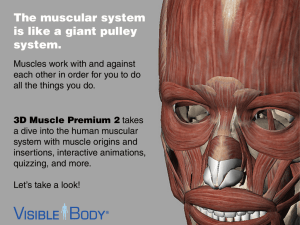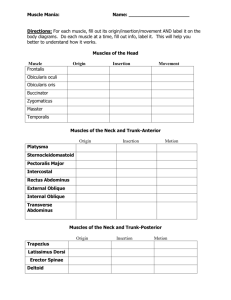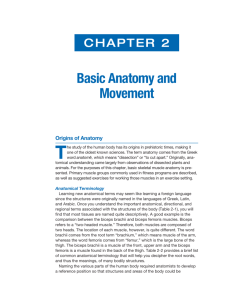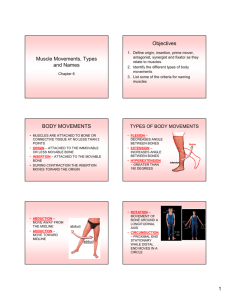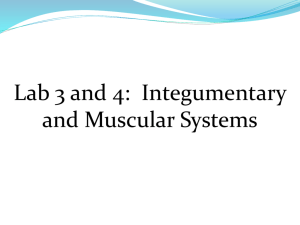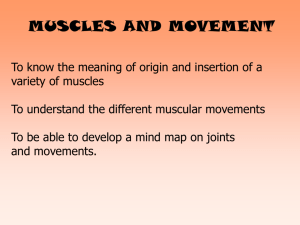Naming Muscles
advertisement
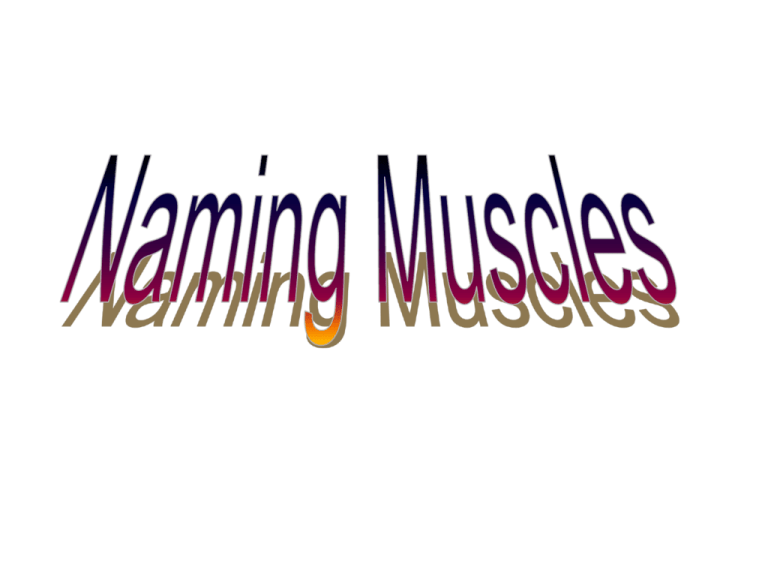
NAMING MUSCLES: Tips • Most skeletal muscles have names that describe some feature of the muscle. • Often several criteria are combined into one name. • Associating the muscle's characteristics with its name will help you learn and remember them. • The following are some terms relating to muscle features that are used in naming muscles. Naming Skeletal Muscles 1 – Location of the muscle 2 – Shape of the muscle 3 – Size of the muscle 4 – Direction/Orientation of the muscle fibers/cells 5 – Number of Origins 6 – Location of the Attachments 7 – Action of the muscle Location: • • • • • • • ____________________ (chest) ____________________ (buttock) ____________________ (arm) ______________________(above) ______________________ (below) _____________________(under or beneath) _______________________ (lateral). Shape: • deltoid (_______________) • rhomboid (like a rhombus with equal and parallel sides) • latissimus (____________) • teres (__________) • trapezius (like a trapezoid, a four-sided figure with two sides parallel). Size: • • • • • ____________ (huge) _______________ (large) __________________(long) ____________ (small) __________________(short) Direction of fibers: • • • • ____________ (straight) _____________ (across) ___________(diagonally) ______________(circular) Number of origins: • biceps (two heads) • triceps (three heads) • quadriceps (four heads) Triceps Brachii Origin long head: infraglenoid tubercle of scapula lateral head: upper half of the posterior surface of humerus medial head: distal two thirds of the posterior surface of humerus Origin and insertion: • sternocleidomastoid (origin on the sternum and clavicle, insertion on the mastoid process) • brachioradialis (origin on the brachium or arm, insertion on the distal end of radius at the styloid process) Action: • • • • • ____________(to abduct a structure) _____________(to adduct a structure) ______________(to flex a structure) _____________ (to extend a structure) _____________ (to lift or elevate a structure) How Muscles Attach to Bone • Indirect Attachment – ___________________ • the _______________________ (sheath of connective tissue that surrounds the exterior of the muscle fibre) extends past the muscle as a ____________________ and then attaches to ____________________________. How Muscles Attach to Bone • Direct Attachment – the epimysium adheres to and fuses with the periosteum Review: • What is origin? • What is Insertion? Try to Remember… • The origin usually stays fixed and the insertion moves closer to it Origin Insertion 3 Basic Types of Muscle Contractions Concentric – ________________________________ – Ex. biceps shorten when lifting an object Eccentric – ___________________________________ – Ex. biceps lengthen as the same weight is placed back on the ground Isometric (static) – _________________________________________ – Ex. trying to lift an immovable object. Push or Pull??? • Muscles _____________ by contracting and relaxing, muscles _________________ • They work in pairs to create smooth movement, they are called _________________________(opposing pairs). Agonist vs Antagonist? • Agonist– • Antagonist - Example: • In elbow flexion, the biceps brachii will concentrically contract while the triceps brachii will eccentrically contract. Fixators/Stabilizer • Muscles that are active isometrically (muscle does not shorten or lengthen) in order to fixate an area when the agonist contracts • Fixators/ Stabilizers - Fixators/Stablizer • Example: When performing a push-up, the serratus anterior stabilizes the shoulder girdle during the downward stage in order to prevent adduction Examples of opposing muscles and muscle groups Elbow flexion Shoulder abduction Medial shoulder rotation Knee extension Wrist flexion Dorsi flexion Trunk flexion Hip flexion AGONIST (Prime Mover) Biceps brachii ANTAGONIST Triceps brachii

